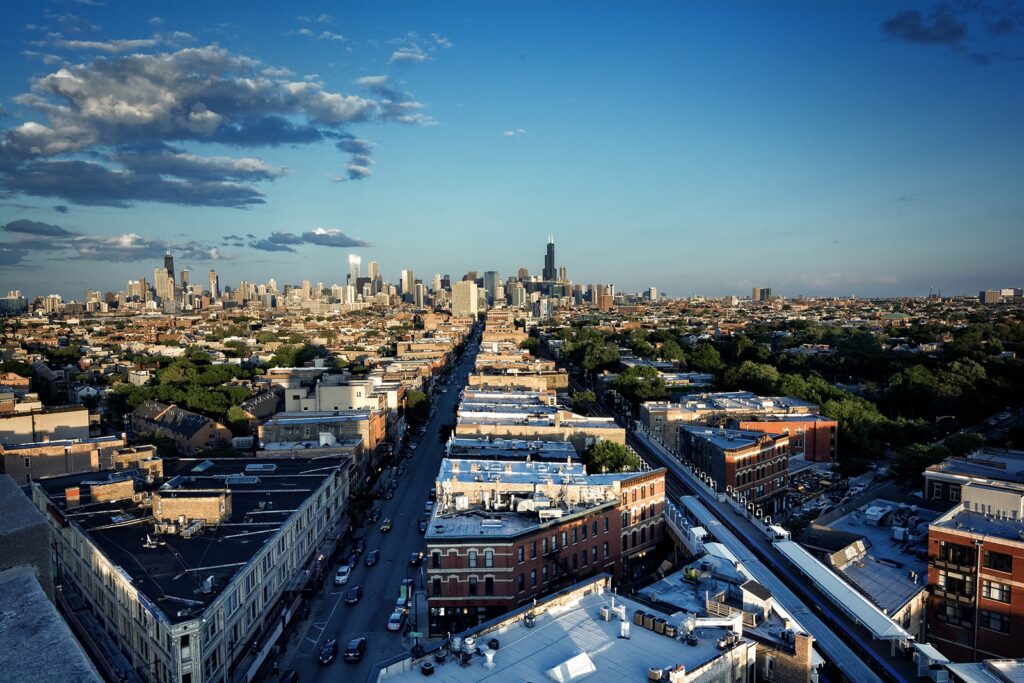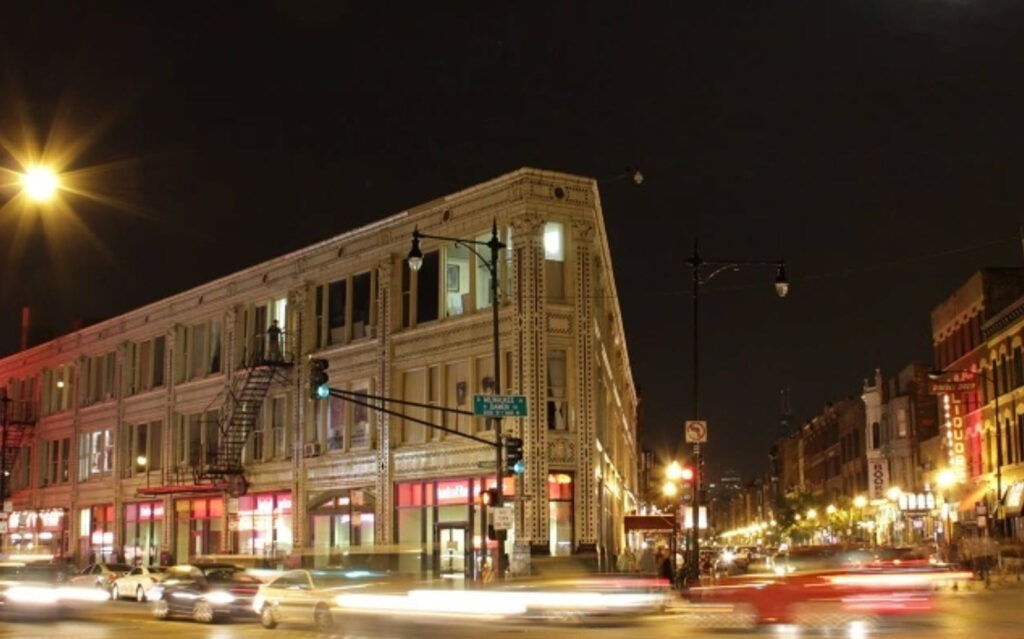
The Chicago neighborhood of Wicker Park is a part of the West Town community and sits alongside the Kennedy Expressway, Humboldt Park, and the Bloomingdale Trail. This area is well-known for its trendy culture, art, nightlife, and culinary attractions.
Situated west of Pulaski Park, northwest of The Loop, north of East Village and Ukrainian Village, east of Humboldt Park, and south of Bucktown, the 4 acre Wicker Park neighborhood is home to Chicago Park District, a popular outdoor gathering spot. Traditionally, the boundaries of the area have been marked by Bloomingdale Trail (also known as the 606) to the north and Armitage at times, Ashland Avenue to the east, Division to the south, and Western Avenue to the west. Wicker Park has also been added to the National Register of Historic Places listings in Chicago and is a designated Chicago Landmark District.
In late 1868, the Chicago Board of Public Works proposed the construction of a park to be located west of Milwaukee Avenue and south of North Avenue. At the meeting, alderman Charles Wicker and his brother Joel decided to purchase 80 acres of land on Milwaukee Avenue and create a subdivision of varying lot sizes with a 4-acre park situated in the middle. This endeavor was further expedited by the Great Chicago Fire of 1871, which encouraged many of the homeless to build new homes.
Towards the close of the 19th century, German and Norwegian immigrants chose to settle in the northern and northwestern parts of the area. Wicker Park became their home, with many affluent Northern Europeans building grand mansions in the most desirable locations, mainly along the streets of Hoyne and Pierce (which was then known as Robey). Hoyne was nicknamed “Beer Baron Row”, due to the numerous wealthy brewers who had established their mansions there.

As the 19th century concluded, the vicinity was subsumed into the nearby regions. The region near Wicker Park was referred to as Polish Downtown, which was also known as the “Polish Gold Coast”. The settlement of West Town increased significantly in the 1890s and 1900s with the immigrations from Poland and the finishing of the Metropolitan West Side Elevated Lines. The area around Division, Milwaukee, and Ashland was once called “Kostkaville”, and the intersection still goes by the names “Polonia Triangle − Polish Triangle”.
During WWI, the provisional government of Poland had their meeting in Wicker Park located in the near Northwest Side. This area became home to many extravagant churches in the Archdiocese of Chicago, each built in the Renaissance Revival and Baroque Revival style of architecture that is popular in the Eastern U.S.
Immigration of Poles to the region intensified during and after World War II, with an estimated 150,000 people arriving in the years 1939-1959 as Displaced Persons. Like the Ukrainians in nearby Ukrainian Village, they congregated in their own ethnic enclaves, with amenities such as stores, eateries, and banks where their own language was spoken. Division Street was referred to as “Polish Broadway”. In the 1950s, poet John Guzlowski, whose parents initially arrived in this area as DPs, observed that “it felt like everyone was a Pole”, as local shopkeepers, clergy, law enforcement officers, garbage collectors, educators, and librarians either conversed in Polish or had family who did.
Nelson Algren’s works, such as The Man with the Golden Arm and Never Come Morning, featured the tales of substance abusers, card players, sex workers, and alcoholics in Division Street, which stirred controversy in the Polish American community due to anti-immigrant sentiment. This resulted in Never Come Morning being banned from the Chicago Public Library for years, as it was seen as Anti-Polonism. These issues were reignited when plans to commemorate Algren by renaming Polonia Triangle were announced, even after his death.
In the 1960s, Wicker Park underwent a radical transformation. The Kennedy Expressway, built in 1960, resulted in the displacement of many residents, as well as a disruption of the Polish-American churches, settlement houses, and community organizations. At the same time, Puerto Ricans and other Latinos, who had been affected by urban renewal in Old Town and Lincoln Park, began moving into the area. In 1960, Latinos made up less than 1 percent of West Town’s population, but that number had increased to 39 percent by 1970. Cut off from Lincoln Park by the Chicago River and then the Kennedy Expressway in the late 1950s and 60s, the area contained the second largest concentration of Puerto Ricans in Chicago, and was the original home of the largest Latino gang in the area, the Latin Kings. The Young Lords, a human rights group led by Jose Cha Cha Jimenez, peacefully worked with the Latin Kings, and organized sit-ins with L.A.D.O. at the Wicker Park Welfare Office, as well as large, nonviolent marches to city hall with the Spanish Action Committee. Urban renewal projects were implemented to address “urban blight” in some parts of the area, however, West Town continued to be affected by disinvestment at a rapid rate, as downtown banks refused to provide loans to the area for much of the mid-20th century.
In the 1970s, Chicago and Wicker Park hit a low point. Hundreds of arson cases occurred in the area, and many small factories shut down or moved away. As a result, the city increased building code enforcement and taxes, and shifted from a manufacturing to a service economy, causing unemployment and the proliferation of prostitution, drugs, and gang crimes on North Avenue between Western and Milwaukee Avenues. Seeing an opportunity, speculators and developers began land grab tours, leading to the displacement of the Puerto Rican community and other low-income residents. Despite this, Wicker Park was still seen as an ideal “suburb within the city” due to its proximity to downtown via Milwaukee and the elevated train.

In the 1980s, the Northwest Community Organization (NCO) made efforts to bolster the community by constructing affordable housing. This coincided with the influx of artists attracted by the area’s proximity to the city center, the cheap inhabitable space in defunct factories, and the urban atmosphere. In 1989, “Around the Coyote” was established as a 501(c)3 non-profit to help the many artists and galleries there gain recognition both domestically and abroad. The festival, set up in the Flatiron Arts Building and typically held in October, lasted for many years. In 2008 it was restructured and relocated downtown, and renamed Looptopia, a move that also marked the start of artists leaving the area for other art scenes in Pilsen, Humboldt Park, Logan Square, Jefferson Park, Rogers Park, and Uptown.
Located close to public transportation and The Loop, Wicker Park is nowadays recognized for its various retail and entertainment spots, which makes it a great place to live for people who work in the downtown area. In 2001, the MTV show The Real World: Chicago was filmed in the district, prompting protests concerning the supposed advancement of gentrification. Over the last two decades, crime in the area has diminished and several new homes have been constructed, as well as old ones being restored, leading to an increase in business. Wicker Park is well-known for being a trendy place, with up-and-coming music bands, high-end fashion stores, gourmet restaurants, European-style cafes, independent supermarkets, and artsy companies. According to a September 2012 Forbes article, the neighborhood was rated the #4 hippest hipster area in the United States.

Wicker Park and its surrounding West Town neighborhoods have encountered climbing real estate values and tax increases due to city levies. In 2016, the municipality as a whole experienced an average rise of 13% in taxes when the property tax was increased and housing values were re-evaluated. Nevertheless, Wicker Park had an average surge of 28.1%. The Bloomingdale Trail (also known as The 606) has contributed to the ascent in property values and has stimulated other great-scale developments.

